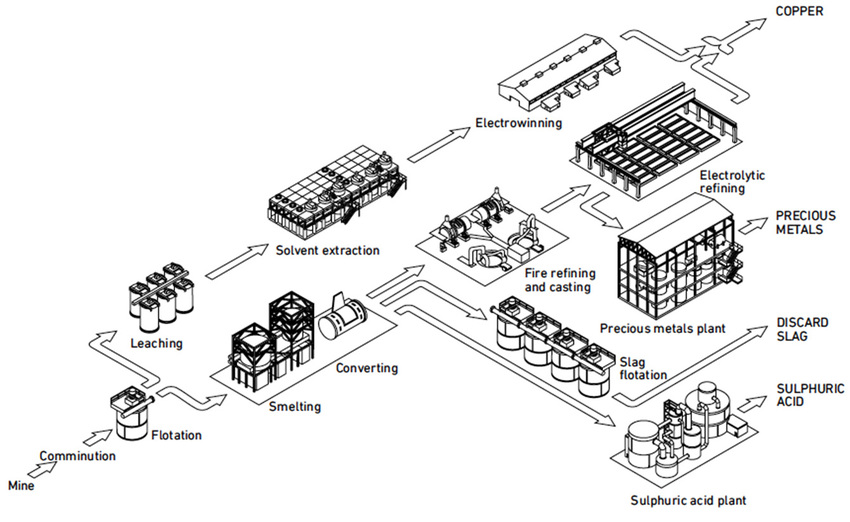Introduction
Copper (Latin cuprum) is a chemical element with the element symbol Cu and atomic number 29. It is a transition metal, in the periodic table it is in the 4th period and the 1st subgroup (according to new counting group 11) or copper group. The Latin name cuprum is derived from (aes) cyprium "ore from the Greek island of Cyprus", where copper was mined in ancient times.
As a relatively soft metal, copper is easy to shape and tough. As an excellent conductor of heat and electricity, it has many uses. It also belongs to the group of coinage metals.
As an important technology or functional metal, copper belongs to the group of semi-precious metals.
Mining
Copper ores are often contain sulphur. Sulphuric acid can be released from mining dumps through weathering processes and washed into the surrounding area by rainwater. The groundwater is because of that in dangerous.
Processing
In the next step , sulphur is going to be seperated from copper. It ist possible that because of that the smelling of SO2 ist very strong und it can cause irritation of the mucous membranes.
Acid rain
Even far-off regions can be affected, as pollutants can be transported by the wind. In this way soil organisms are disturbed and plant communities are damaged.
Example
Copper is often used in cabels and pans. It is a good conductor of electricity. 
https://dontwastemy.energy/2017/01/20/copper/
The hole text, audio and vocabulary you can see at Anabel's post.
My apartment have oil heating.
Heating oil is any petroleum product or other oil used for heating; a fuel oil. Most commonly, it refers to low viscosity grades of fuel oil used for furnaces or boilers use for home heating and in other buildings. Home heating oil is often abbreviated as HHO.

The Werdhölzli waste water treatment plant, also known as ARA Zürich-Werdhölzli, is the waste water treatment plant for the city of Zurich.
With a population equivalent of 670,000 people, it is the largest sewage treatment plant in Switzerland.
In addition to the city's wastewater, it also treats wastewater from the municipalities of Zollikon, Wallisellen and Kilchberg, as well as a partial amount from the municipalities of Adliswil, Rümlang and Zumikon.
The plant is operated by Entsorgung + Recycling Zürich.
https://www.stadt-zuerich.ch/ted/de/index/entsorgung_recycling/wissen/wasser/klaerwerk.html

Located in: Bändlistrasse 108, 8064 Zürich
I have tried to realize the most important needs of man in one space. To survive we need water, food, oxygen and light. This experiment that I have tried to describe in this project can not be proven 100% and I hope this will never be the case, but if the day should come, we people of today will be prepared for it.

Every human being is dependent on food. This I have also thought about in such an emergency. We cannot make food stocks for the next 100 years, but we can eat and breed animals and thus increase our lifespan.
The main three animals include: Cows, chickens and sheep. Cows produce enough meat and milk so that we also have enough iron in our bodies. Chickens can and also give meat and eggs. This is also essential when it comes to pregnancy. Last but not least, sheep. The sheep bring us not only food, but also enough fur to stand firm in cold temperatures.



Through trees and plants we can get enough oxygen to survive in an enclosed space. The trees are planted naturally and watered with the water produced. So that it has a good growth and thus can bring enough oxygen in circulation, I will produce the light with the self-produced electricity. I am firmly convinced that with this method some people can manage for a longer time without the surface of the world.
Producing your own electricity is the best way when mine is trying to survive in an enclosed space. One lowers the depression through the sport and thus produces Storm to have enough light and heating.
Equipment:
light column, about 1.80 m high with 16 levels for about 20 to 800 watts of mechanical power.
Possible displays:
Speed (km/h), cadence (rpm), distance covered (km), current mechanical power (watts), current electrical power (watts), accumulated power/work (Wh or kWh), donation total (€), voltage (volts), current (amps), ranking list with name display (separated by persons/teams), bar charts, picture/graphic overlays, various multipliers (e.g. calories, ml fuel oil, grams biomass, electricity price, light bulb duration ...), logo

Material: tantalum hafnium carbide (melting point: 4215 degrees Celsius).
Heat: Heat 2000+ degrees Celsius
Conduit: Platinum/Diamond
Hydrogen = Water
Namely: it's like a bowl heated by a lighter.
You take the strongest material & heat it. The heat is controlled and
heated by electricity. Thus hydrogen is produced and finally flows down to the
tap water.
I added a filter to it because the water needs to be cooled.
In the end, we have drinkable water that will last forever.
